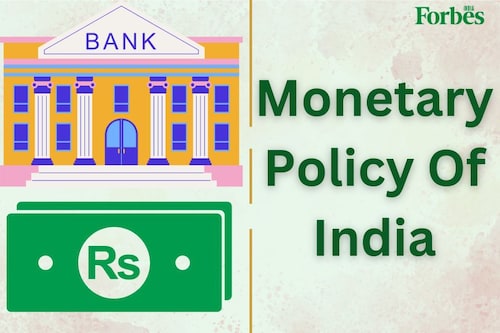Monetary Policy Of India: From types, tools and composition, details you need to
Learn all about India's monetary policy: types, latest updates, and the differences between monetary and fiscal policy


Monetary policy helps shape a country"s economic landscape by influencing key factors such as inflation, economic growth, and employment.
Through tools like interest rate adjustments and money supply control, the Reserve Bank of India seeks to maintain price stability, ensuring that inflation remains at a sustainable level. Central banks also impact borrowing costs, consumer spending, and business investments by managing interest rates.
Effective monetary policy contributes to economic stability, fostering an environment conducive to sustainable growth.
The bi-monthly monetary policy updates as of January 2024 are as follows:
The next MPC meeting is scheduled for February 6-8, 2024.
Various types of monetary policy offer central banks a flexible toolkit, adaptable to the diverse challenges presented by different economic conditions.
An expansionary monetary policy is employed when a central bank aims to stimulate economic activity. This involves lowering interest rates to make borrowing more affordable encouraging spending and investment.
The increased money supply resulting from lower interest rates is expected to boost consumer demand and business expansion, fostering economic growth.
In a contractionary monetary policy, central banks raise interest rates to make borrowing more expensive, reducing spending and investment. The goal is to slow down economic activity and prevent excessive inflation.
In 2015, the Monetary Policy Framework Agreement was signed between the Reserve Bank of India and the Government of India. This agreement, recommended by RBI Deputy Governor Urjit Patel, establishes measurable objectives for India"s monetary policy.
The primary aim of this framework is to ensure price stability while considering the objective of economic growth.
Under this arrangement, the RBI determines policy interest rates to maintain inflation within 4 percent, with a permissible range of +/-2 percent.
The RBI issues biannual reports detailing the inflation"s source points and forecasting its trajectory for the next 6 to 18 months. If consumer inflation exceeds 6 percent or falls below 2 percent for three consecutive quarters, the central bank is determined to have missed its inflation-targeting objective. In such cases, the RBI submits a report to the government explaining the reasons and outlining corrective measures. The Committee estimates the duration required to return to the target range of 2-6 percent.
Disputes related to the interpretation and implementation of inflation targeting are resolved through discussions between the Governor and the central government.
The amended RBI Act of 1934, specifically Section 45 ZB, empowers the Central Government to establish a six-member Monetary Policy Committee (MPC) to oversee inflation targeting in India to promote a robust economy.
Its six members consist of three internal members appointed by the Reserve Bank of India (RBI) and three nominated by an external selection committee. The members include the RBI Governor serving as the ex-officio chairperson, the Deputy Governor in charge of monetary policy, one officer nominated by the Central Board of the Bank, and the remaining three appointed by the union government through a search committee.
The search committee, formed by the Cabinet Secretary, the Secretary of the Department of Economic Affairs, the RBI Governor, and three experts in economics or banking nominated by the central government, selects MPC members who hold office for a non-renewable term of 4 years.
The MPC is required to convene at least four times annually, with a quorum of 4 members for each meeting. Each MPC member holds one vote, and in the case of a tie, the RBI Governor possesses a casting vote. Following each MPC meeting, the committee"s adopted resolution is made public.
Monetary policy tools provide a means to manage the money supply, control interest rates, and stabilise the financial system. The six tools of the monetary policy of India are:
Monetary and fiscal policy are crucial components of a government"s economic toolkit, each serving distinct roles in managing and stabilising the economy.
The implementation and authority lie in different hands: monetary policy of India is executed by the central bank, the Reserve Bank of India, using tools like interest rates and reserve requirements to control the money supply, while fiscal policy is crafted and implemented by the government, influencing the economy through decisions on taxation, government spending, and borrowing.
The time horizon for their impact differs, with India"s monetary policy acting relatively quickly, whereas fiscal policy measures may have a more delayed effect.
While monetary policy primarily affects financial markets and interest rates, fiscal policy has a broader impact on the entire economy, directly influencing government expenditures, taxation, and overall demand.
The objectives of these policies vary, with monetary policy aiming to control inflation and promote economic growth. In contrast, fiscal policy strives to achieve full employment, economic growth, and price stability through government spending and taxation policies.
Flexibility also distinguishes them, with India"s monetary policy often considered more adaptable due to the central bank"s ability to make quick adjustments. In contrast, fiscal policy changes may require legislative approval and are subject to political considerations.
First Published: Jan 23, 2024, 18:02
Subscribe Now